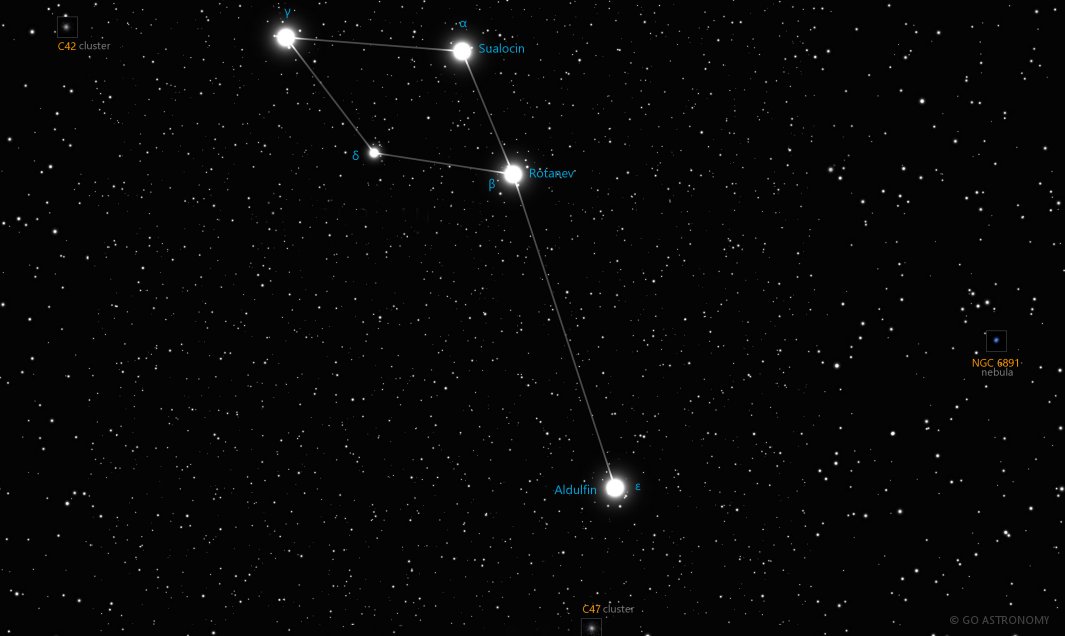Delphinus, the Dolphin (Del)
(del-FINE-us)
The Northern constellation of Delphinus, the Dolphin, is best viewed in Fall during the month of September.
Delphinus is the 69th largest constellation. It's brightest star is Rotanev at magnitude 3.63. The boundary of the Delphinus constellation contains 5 stars that host known exoplanets.
Delphinus is an equatorial constellation, which means its bulk intersects the celestial equator or comes within 10-15 degrees of doing so. Delphinus is visible from most places on Earth.
- Pronunciation:
- del-FINE-us
- Meaning:
- Dolphin
- Genitive:
- Delphini
- Abbreviation:
- Del
- Asterism:
- Job's Coffin
- Constellation Family:
- Heavenly Waters
- Hemisphere:
- Northern
- Quadrant:
- NQ4
- Visibility:
- 90° N - 70° S
- Best viewing month*:
- September
- Area:
- 189 sq. degrees
- Size:
- 69th largest
- Equatorial:
- Yes
- Right Ascension (avg):
- 20h 40m
- Declination (avg):
- 13°
- Brightest star:
- Rotanev (3.63)
- Stars with planets:
- 5
- Messier objects:
- |
Brightest Stars in Delphinus
The 10 brightest stars in the constellation Delphinus by magnitude.
- Star
- Magnitude
- Spectral class
- Beta Delphini (β Del)
- 3.64
- F5IV
- Alpha Delphini (α Del)
- 3.77
- B9V
- Epsilon Delphini (ε Del)
- 4.03
- B6III
- Gamma Delphini (γ2 Del)
- 4.27
- K1IV
- Delta Delphini (δ Del)
- 4.43
- A7IIIp d Del
- Zeta Delphini (ζ Del)
- 4.64
- A3V
- Rho Delphini (ρ Del)
- 4.94
- A2V
- Kappa Delphini (κ Del)
- 5.07
- G5IV+
- Gamma Delphini (γ1 Del)
- 5.15
- A2Ia+
- 17 Delphini (17 Del)
- 5.19
- K0III
Double Stars in Delphinus
These are the brightest and easiest-to-find double, triple, and quadruple star systems in the constellation Delphinus. Also see all star clusters.
- Star system
- Magnitudes
- Type
- Gamma Delphinus
- 4.4, 5.0
- double
Star Clusters in Delphinus
The most notable and easy-to-find star clusters in the constellation Delphinus . Also see all star clusters.
Nebulae in Delphinus
Notable and easy-to-find nebulae in the constellation Delphinus . Also see all nebulae.
Galaxies in Delphinus
The most notable galaxies in the constellation Delphinus. Also see all galaxies.
The Dolphin Constellation
Delphinus, the Dolphin, is a small but fascinating constellation located in the northern sky. Recognizable for its diamond-shaped pattern, Delphinus has been a prominent feature of celestial cartography since ancient times and holds a unique place within the field of astronomy.
Historical Background
Delphinus is one of the 48 constellations listed by the 2nd-century Greek astronomer Ptolemy, and it remains one of the 88 modern constellations recognized by the International Astronomical Union. Its name, derived from Latin, means "dolphin," and it is commonly represented as such in celestial atlases. Many ancient cultures associate this constellation with water and marine life due to its aquatic shape and proximity to the celestial sea - a region of the sky populated by water-related constellations such as Aquarius and Pisces.
Main Features and Location
Delphinus is positioned in the fourth quadrant of the Northern Hemisphere (NQ4) and can be seen at latitudes between +90? and -70?. Although it's small and faint, it's relatively easy to find due to its distinctive shape and location near the celestial equator.
The constellation is often referred to as "Job's Coffin," due to its diamond or coffin-like asterism. The diamond pattern depicts the body of the dolphin, while a fifth star near the diamond gives the impression of a dolphin leaping out of the water.
Significant Stars
Delphinus has several significant stars, including its alpha and beta stars, Sualocin and Rotanev. Interestingly, both these star names were coined by Italian astronomer Nicolaus Cacciatore; they are his Latinized name spelled backward.
Sualocin, Alpha Delphini, is a complex system of at least five stars, about 240 light-years away from the Sun. Its primary star is a blue-white subgiant. Rotanev, Beta Delphini, on the other hand, is a binary star system approximately 101 light-years away. Both stars in the Rotanev system are white main sequence stars.
Deep Sky Objects
While Delphinus doesn't host any Messier objects, it does contain several deep sky objects that are of interest to astronomers. The globular cluster NGC 6934, located about 52,000 light-years away from us, is one of these notable objects. Another is NGC 6891, a high-surface-brightness planetary nebula that represents the outer layers of a dying star expelled into space.
Observation
Despite its small size and lack of particularly bright stars, Delphinus is relatively easy to spot, especially in summer and early autumn. From the Northern Hemisphere, you can locate it in the eastern sky following the Summer Triangle, formed by the bright stars Vega, Deneb, and Altair. Once Vega and Deneb have been identified, Delphinus can be seen to the east.
In the Southern Hemisphere, Delphinus appears lower in the northern sky and can be best viewed in late winter and early spring. Its visibility depends greatly on the observer's latitude and the level of light pollution.
* Constellation shown for northen hemisphere skies. For the southern hemisphere, constellations appear rotated 180 degrees (upside-down and left-right reversed) from what is shown. Remember that seasons are reversed too - summer in northern latitudes is winter in southern latitudes.
** Circumpolar constellations are visible year-round in the hemisphere listed (and not at all in the opposite hemisphere).





